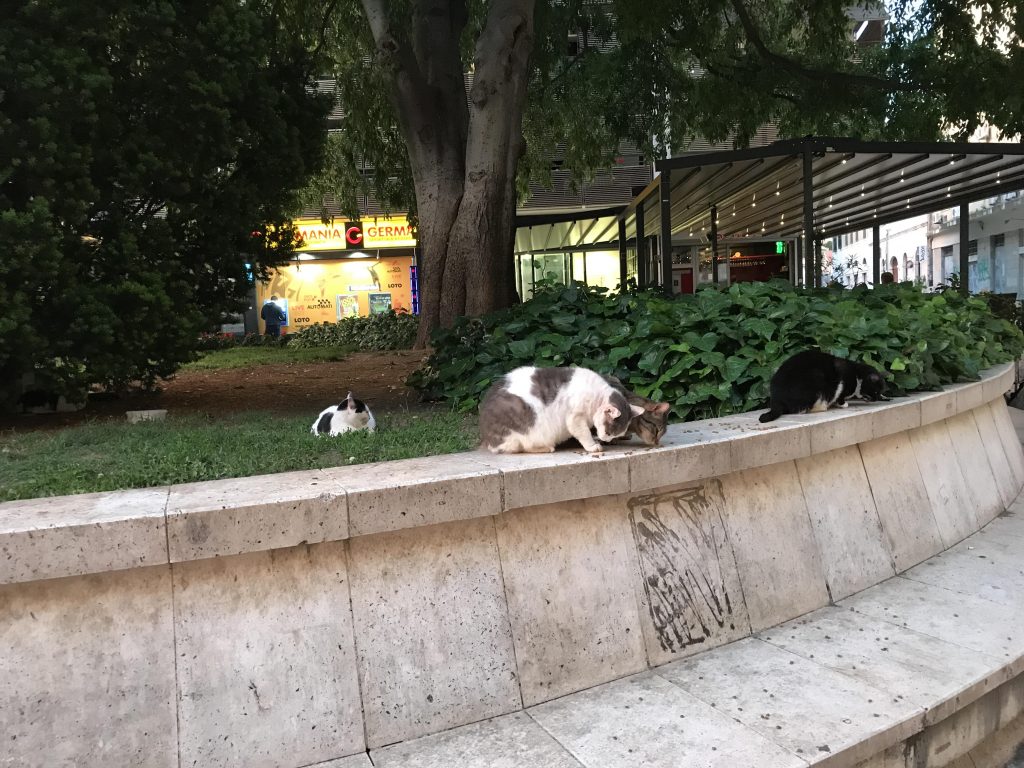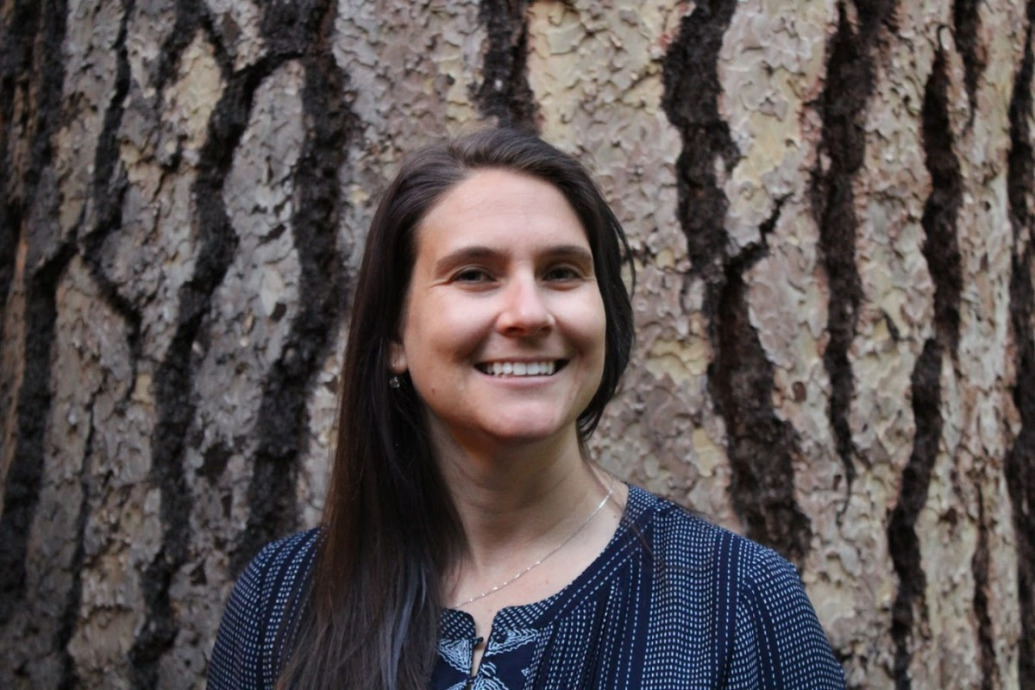In the morning, we grabbed breakfast around 1100 on the waterfront promenade and formulated a day-plan for learning about Diocletian and Split history. We finally felt relaxed because the weather was 70 degrees and sunny, and we had 3 nights for once in a city. Staying in one place for a while was something I had been missing. We had arrived late the night before.
First, we strolled again by the fish market which was in its prime.
We made again for the waterfront, looking to take in some Split sun and people watching. Palm trees and flip flops. It reminded me of Santa Monica, California. It also had an element of poshness to it.
For breakfast, we ate at Brasserie 73. It had lovely atmosphere right on the water, and we were especially intrigued with the waiter call button – whenever you needed service, you just had to press it, the waiter would get a text.
Brendan got the double decker breakfast consisting of an asparagus omelette (asparagus were big in Split we found) and bananas foster French toast, which was honestly too big for one person.

I ordered the continental breakfast assortment of breads and pastries, and we shared everything. We also enjoyed two large Americano coffees, which was the thing to ask for if you wanted a hefty amount (even if it was weaker than espresso).
Fueled by a good breakfast, we decided to sign up for the 1300 Split walking tour that we booked through Trip Advisor/Viator. We had about 30 minutes to kill so we continued to explore the waterfront.
Our final stop prior to the tour was the town market, where we saw all sorts of lovely fruits, vegetables, flowers, and crafts for sale.

We met up with Nataša (pronounced Natasha) and the small group near the Golden Gate by the statue of Gregory of Nin. Croatia has a law in place than any tourism has to be paid for, so the free walking tours sponsored by the city destination management organizations are not allowed – but there are many walking tours offered by private tour operators like the one we found with the same format. This one was a “blue umbrella” tour (as opposed to our yellow umbrella free walking tour in Ljubljana).
The main focus of this tour is on the walled city, which is the 4th century palace of Roman Emperor Diocletian. In 1979 this area was named a UNESCO heritage site. Nataša started the tour explaining the palace and the history of Diocletian (born 244 and died 311) . He was a very interesting man that rose from the ranks of a lowly soldier to Emperor, and added stability in to the governance structure during his rule. Diocletian became emperor after Emperor Carus was assassinated, and Diocletian revenged his death by assassinating the assassin. The military then proclaimed him emperor, as the natural choice (as Brendan mentioned, it was all part of his plan, very Tyrion like 😉 ).
Diocletian set up a co-emperor system late in the 3rd century so that the empire wouldn’t destabilize if he got assassinated (and this also reduced the temptation of assassination for power in the first place). He then went a step further and designated junior co-emperors, for a system of 2 successors to replace the 2 co-emperors, and so on and so forth. This wise political system was called a tetrarchy, and led to a time of stability and prosperity for the empire. He abdicated his rule in 305, the first emperor ever to do so, and retired to his palace in Split. He ruled for about twenty years, from 284 to 305.
Diocletian wasn’t perfect – he did run a campaign to limit the legal rights of Christians in 303, and was obviously on the wrong side of history there.
But, all in all, Diocletian did much more good than harm.
Here are some pictures of the Diocletian Palace, starting from the outside of the Golden Gate. The Golden Gate wasn’t a gate made of gold, but because it was the most ornate, and the gate that would welcome important visitors.

So in essence, Split was a retirement villa/palace for Diocletian, and wasn’t even an important city until later on. The more important city than Split during Roman times was actually Salona (Solin) up until the 7th century, just north and slightly inland of Split – it’s now in ruins after it was sacked by the Slavs and the population mostly relocated to Split. Solin is near where Diocletian was born. After Solin was sacked, Split began to thrive with the Solin citizens fleeing to it for safety. Now Split is the second largest city in Croatia today, second only to Zagreb the capital.
We then starting moving around the grounds and in to the interior, but not before passing by this guy – Gregory of Nin.
Gregory of Nin was a Croatian bishop who convinced the Catholic church to allow religious services to take place in Croatian rather than Latin, earning the Croatian language a higher standing in Catholicism and Christendom. Apparently, rubbing his toe grants you a wish.

Gregory of Nin, as well as most of the sculptures around Split, was sculpted out of bronze by Croatian sculptor Ivan Meštrović. He used his nose and face or his wife’s nose and face for most of the sculptures you can see around the city. The nose is unmistakable.
We continued inside the palace for more architectural exploration, through the Golden Gate and towards the center. We stopped to admire the granite, limestone, and large Roman streets (able to fit two carriages passing side by side) as well as the tiny chapel built in to the city wall just in the interior of the Golden Gate.
Side note – there is also an Eastern Gate (Silver Gate), a Western Gate (Iron Gate), and a Southern Gate (Seagate). Our hotel was near the Iron Gate. The living quarters and the more ornate portions of the palace were towards the south, on the sea-facing side, and this is where Diocletian actually lived.
We then entered in to the court (called a peristyle), and it was surrounded by several sphinxes that Diocletian brought from Egypt. One one is in tact today, and is 3500 years old. This area is also where the temples (to Jupiter and Aesculapius) were set up as well as Diocletian’s mausoleum, which is now the Cathedral of Saint Domnius. It was being restored when we visited.
Our guide pointed out a basement underneath the courtyard to visit for souvenirs, which we later did (we ended up buying some stained glass art from a local artist, Olja Einfaltart). This basement is also where they filmed the dragon holding area in Game of Thrones in Meereen.
We also got to check out this filming location for when Ser Barrister Selmy dies saving Grey Worm’s life during the Sons of the Harpy Meereen attack (Season 4).

After checking out inside the Diocletian Palace, we went outside and learned more about Split history, starting at the waterfront. But first, we took a break for some gelato. I had mint and Brendan found espresso caramel.
We gobbled it up as a similar history to Slovenia was recounted to us, but here with obviously a more significant Roman influence. In the 6th century when the western Roman empire fell and Salona was sacked by the Slavs, Christians and other Romans were forced to flee to Split. Split at this time became an eastern Roman (Byzantine) city, with some Hungarian influence. It then fell under influence of Venice, France (Napoleon), the Austro-Hungarian Empire, and then Yogoslavia and the pan-southern Slav movement that swept the region, as well as the eventual unraveling of the same.

We wandered through several other squares in the old city but outside the Diocletian Palace, like this square – where we saw another statue by Ivan Meštrović.

We enjoyed the various alleyways and ins and outs of Split. You turn down a new alley and there’s always a new surprise waiting.
At the end of the tour, near the Jewish quarter and the one remaining synagogue, we took a picture with Nataša. We also learned about nepotism, via another ruler, Julius Nepos (see the sign below!).

Feeling pretty good after our tour, we decided to press on and hike up the hill starting on the west side of the corniche. It was a 30 minute or so climb up, and we were rewarded with some splendid views along the way.
This one cracked us up.

A minute later it took a leak. Dogs.
At the top, we were rewarded with some great panoramic views of the mountains, the harbor (complete with cruise ships), the Croatian flag, and a Rio styled cross.
On the way down we met up with this guy.


We then strolled the west side promenade, which was not much to write home about. It was shabby, in fact, and needed redevelopment. It did offer good views of the city.

We loved all the cats we were seeing. They were brought in for the rats hundreds of years ago, and never left. The city takes care of them.

For dinner that night, we decided it was time for pizza. After some review reading on Trip Advisor, we decided on Pizza Portas, in a hidden enclave in the Diocletian Palace.
On the way we said hi to the cats in the park near our hotel, both before and after dinner. There were always some there to greet us, and usually they had some kibble available, courtesy of the citizens of Split.
I ordered a bottle of red, and made it through half during dinner. I’d say it was a big red, lots of flavor but not too much tannin flavor, and it went great with pizza. It was really nice to be able to just walk out of the restaurant with it. Nobody cared at all – in fact people were walking around the city with beers and other drinks.

We both ordered pizza for dinner – Brendan got an arugula, cherry tomato, and mushroom, and I got the vegetarian pizza and subbed mushrooms for corn. Corn apparently was a common vegetable to be found on pizza, we discovered.

We skipped dessert in lieu of a hunt for ice cream, and ended up going to Hajduk, named after the Split soccer team and a favorite of our guide
Nataša. I got Oreo and Brendan got Nutella. We thought it was just OK – they were small and didn’t have much flavor, and were missing some of the texture (of cookies or crunch) that we had come to expect from Sweet Cooies, our neighborhood place in Denver.
On our walk back we found this fun display.

There are so many reasons to love Split. Mediterranean lifestyle. History. Cats. Mountains. Riviera. Hidden passages. Roman palaces. Game of Thrones. Split is the jewel of the Dalmatian Coast, and our new favorite seaside vacation city.




































